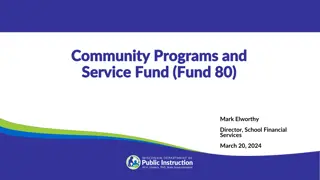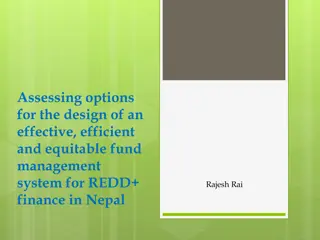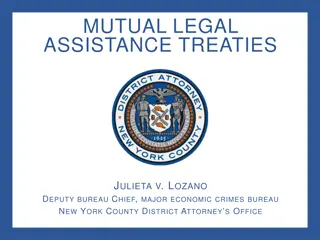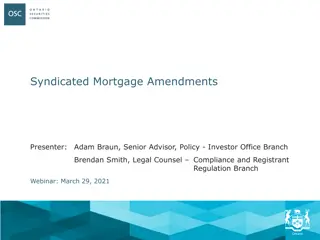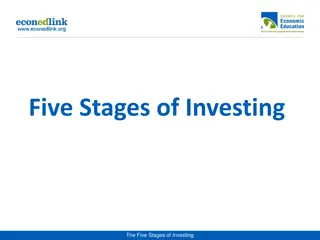Guidelines and Regulations for Mutual Fund Investments in India
SEBI, the regulatory authority in India, aims to protect investors by simplifying mutual fund schemes and promoting transparency. Guidelines cover structure, categorization, and investment regulations for equity, debt, balanced, and solution-oriented funds.
Download Presentation

Please find below an Image/Link to download the presentation.
The content on the website is provided AS IS for your information and personal use only. It may not be sold, licensed, or shared on other websites without obtaining consent from the author. Download presentation by click this link. If you encounter any issues during the download, it is possible that the publisher has removed the file from their server.
E N D
Presentation Transcript
Mutual Fund MRS. M. MARIA JESSICA PG & RESREACH DEPARTMENT OF COMMERCE, BON SECOURS COLLEGE FOR WOMEN, THANJAVUR
SEBI GUIDELINES REGARDING MUTUAL FUND INVESTMENTS Board of India), works for the protection of investors interest in securities while regulating and promoting the securities market. The organisation has created guidelines for investors to gain awareness regarding the manner in which mutual funds function by offering the required information. The regulator aims to simplify the wide variety of schemes that tend to confuse investors due to their complexity. The guidelines regarding the consolidation and merger of MF schemes are created in an effort to make it easier for investors to compare different schemes made available by mutual fund companies. The regulator for markets in India, SEBI (Securities and Exchange
GUIDELINES REGARDING STRUCTURE Guarantor as someone who introduces a mutual fund. The guarantor s role is to generate revenue through the launch of a mutual fund. The fund is then handed to a fund manager. A sponsor, according to the guidelines, is defined as someone who sets up schemes in keeping with the regulations of the Indian Trust Act, 1882. Sponsors primarily have the role of listing the schemes with the Securities and Exchange Board of India. The guidelines regarding the structure of schemes define a
Contd The Securities and Exchange Board of India is responsible for making policies related to mutual funds. It also has the responsibility of regulating the industry and laying down the law so that investors interest is safeguarded. So far as asset allocation and investment strategy are concerned, mutual funds can be very different from one another. The new guidelines have focused on uniformity so far as the functioning of schemes is concerned. Investors will, therefore, find it easier to make investment decisions.
Contd To make things standard and to introduce uniformity in schemes that are similar to one another, the following is the manner in which mutual funds are categorized: Equity funds Debt funds Balanced or hybrid funds Solution-oriented funds Other funds
SEBI REGULATIONS FOR INVESTMENT IN MUTUAL FUNDS Mutual funds have been categorized into 5 groups equity, debt, balanced, solution-oriented, and other. Only one scheme is permitted in each category, apart from ETFs or index funds, thematic or sectoral funds, and fund of funds. Apart from laying down the law, the Securities and Exchange Board of India has also created guidelines for investors.
SEBI GUIDELINES FOR INVESTORS Assessing personal finances Research information regarding schemes Diversification of portfolios: Refrain from cluttering portfolios Assign time frames
ASSESSING PERSONAL FINANCES Mutual funds are highly diverse investment options. As a result, they carry some risk with them. Investors are urged to be clear when they assess their financial standing. They are also asked to be careful when assessing their ability to bear risk in case a scheme does not perform as expected. The risk appetite of investors must be considered individually in keeping with each scheme.
RESEARCH INFORMATION REGARDING SCHEMES Before making investments in mutual funds, it is essential for investors to attain detailed information regarding the scheme in which they wish to invest. Equipping yourself regarding your investment options will make it easy to make the right decision. with all the details
DIVERSIFICATION OF PORTFOLIOS Investors carefully by diversifying their portfolios. As a result, the potential to mitigate risks or maximize profits of potentially major losses increases. Diversification of portfolios is instrumental in gaining sustainable results. can spread their investments long-term financial
REFRAIN FROM CLUTTERING PORTFOLIOS Select the right funds to create a portfolio needs professional management of the schemes in addition to careful monitoring. Investors should ensure that their portfolio is not cluttered while choosing the number of schemes to add to their portfolio in order to ensure that the schemes can be well-managed individually as well as collectively.
ASSIGN TIME FRAMES Investors are advised to ensure that a time frame is assigned to each scheme in order to ensure that the plan grows. If there is stability in the maintenance of the schemes, market fluctuations and volatility can be curbed significantly.
ASSET MANAGEMENT COMPANY (AMC) the investors and invests it into different investment options such as equities, debt, real estate, gold etc. There can be multiple funds with different investment objectives managed by an asset management company. An AMC is run by fund managers who first set the investment objective, evaluate market risk and reward profile and then decide the investment strategy. For example, a debt fund of an AMC would primarily invest in bonds and government securities and the investment objective is to generate moderate returns but at minimal risk. An asset management company is a firm which pools funds from
Who Regulates AMCs? An Asset Management Company (AMC) is regulated by the capital market regulator, Securities and Exchange of India (SEBI). Further, AMCs are also passively regulated by the Association of Mutual Fund of India (AMFI) in order to protect the interests of the investors.
How does an AMC manage the funds? List of all necessary steps than an AMC undergoes, in order to perform at par with its peers : Efficient Asset Allocation: To maintain investors trust, an AMC has to judiciously invest their money in different types of investment instruments. Distribution of assets amongst debt and equity depends on the market conditions and prospective interest rates. Professional expertise and experience of fund managers plays a great role in efficiently allocating resources to different asset classes.
Contd Formulating an Investment Portfolio: Constructing an investment portfolio is the most crucial decision an AMC takes. It involves a thorough amount of research and analysis to formulate a risk - adjusted portfolio, which will not underperform even during turbulent market swings. Taking calculated risks in case of equities and investing in highly rated securities is how fund managers construct a portfolio. Assessment of Performance: The AMCs are answerable to its investors and trustees for its investment decisions. For this, periodic assessment of fund performance is done taking into consideration the fund returns, NAV Value, asset allocation, etc. This review sheet is available to all the investors and trustees of the AMC.
Contd Mutual funds, Index Funds, Exchange Traded Funds (ETFs) etc., are all examples of various types of funds managed under an umbrella AMC. AMC MUTUAL FUND IN INDIA: ICICI Prudential Mutual Fund HDFC Mutual Fund Aditya Birla Sun Life Mutual Fund Reliance Mutual Fund SBI Mutual Fund L&T Mutual Fund Kotak Mahindra Mutual Fund Franklin Templeton Mutual Fund DSP Mutual Fund Axis Mutual Fund IDFC Mutual Fund UTI Mutual Fund Motilal Oswal Mutual Fund MiraeAsset Mutual Fund







